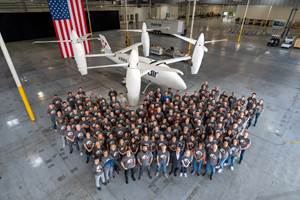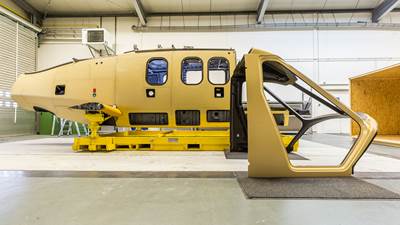Piasecki acquires former Lockheed Sikorsky facility for VTOL development
Former Heliplex facility in Coatesville, Pennsylvania, will be transformed into an R&D center for VTOL and UAS aircraft, including Piasecki’s HAXEL demonstrator and PA-890 which use composites.
From left to right: Mike Stanberry, Mike Hirschberg, Rick Siger, Arthur Kania, Fred Piasecki, Rep. Chrissy Houlahan, Dr. Martine Rothblatt, John Piasecki, Greg Piasecki, Val Miftakhov, Michael Tremlett and Bill Moeller. Photo Credit: Piasecki
Advanced rotorcraft technology company (PiAC, Coatesville, Pa., U.S.) has acquired the former Lockheed Martin (Bethesda, Md., U.S.) Sikorsky Heliplex facility in Coatesville, Pennsylvania, which previously served as a production and delivery center for Sikorsky’s S-76 and S-92 helicopters.
The company will transform the 219,000-square-foot state-of-the-art facility into an advanced research and development (R&D) center for next-generation vertical takeoff and landing (VTOL) aircraft, unmanned aerial systems (UAS) and related enabling technologies. Notably, the company’s forthcoming PA-890 zero-emission hydrogen fuel cell rotorcraft, will be built and tested there. The “slowed-rotor winged compound helicopter” concept, as currently envisioned, will have a carbon fiber composite fuselage, according to . Moreover, the hydrogen-powered coaxial helicopter demonstrator HAXEL, to be used to perform the company’s first human-carrying, hydrogen-powered helicopter flight test, “two counter-rotating, two-bladed composite rotors with a diameter of 6.5 meters.” Its cabin and tail are also comprised of carbon fiber-reinforced composite materials.
The Coatsville facility — which includes engineering development, aircraft assembly, paint and finishing facilities, and a well-equipped production flight test and delivery center — will open its doors to employees in the fall and is expected to attract about 400 workers by 2028.
“This world-class facility will serve as a strong foundation for future growth and will enable us to expand our R&D and production capabilities as we deliver transformational vertical lift technologies to the defense and commercial markets,” John Piasecki, CEO of PiAC, says. “We chose to expand our development capabilities in the Delaware Valley because of its deep roots within the helicopter industry, its highly talented workforce, and its robust supplier network.”
This year also marks 80 years of innovation at PiAC in vertical flight, which began in 1943 with the PV-2 helicopter. “Shortly after, PiAC developed the world’s first tandem rotor helicopter — a revolutionary design that has been instrumental in life-saving missions around the globe since WWII — and which lives on in Boeing’s CH-47 Chinook helicopters,” Piasecki continues. “PiAC is building on this legacy with a truly groundbreaking vertical lift technology portfolio, including advanced digital flight control and flight automation technology, hydrogen fuel cell and hybrid propulsion systems, morphing aerostructures and more. We work closely with partners in government, academia and industry to advance these technologies and develop platform and system-level air vehicle integrations as well as conduct flight tests.”
In addition to the PA-890 eVTOL, major PiAC R&D programs currently being executed include the aerial reconfigurable embedded system (), a modular multi-mission tilt duct VTOL vehicle that can be operated unmanned (UAS) or with an optional manned flight module, and the company’s adaptive digital automated pilotage technology (), a flight control software package designed to achieve improvements in safety/survivability, performance and affordability for U.S. military and commercial aircraft.
For related news, read “HyPoint, Piasecki Aircraft collaborate to develop, certify eVTOL next-generation hydrogen fuel cells.” The fuel cell system, to be developed for the PA-890, will most likely use composites, per Hypoint’s partnership with GTL for ultralight liquid hydrogen tanks.
Related Content
Joby flies two eVTOL aircraft simultaneously in testing milestone
The latest in the company’s flight testing program targets certification testing acceleration and support of its passenger-carrying goals by 2026.
Read MorePrepreg compression molding supports higher-rate propeller manufacturing
To meet increasing UAV market demands, Mejzlik Propellers has added a higher-rate compression molding line to its custom CFRP propeller capabilities.
Read MoreJoby conducts FAA testing, moves into final certification
Successful static loading testing of tail structure and Type Inspection Authorization by FAA pilots moves Joby closer to its 2025 targets.
Read MoreOverair completes assembly of full-scale Butterfly eVTOL vehicle prototype
Overair heads to flight testing in early 2024, marked by rapid prototype development.
Read MoreRead Next
Leveraging motorsports composites for next-gen rotorcraft
FastCan consortium integrates hollow, solid and cored CFRP into single-cure, single-piece canopy for reduced weight and cost.
Read MoreCutting 100 pounds, certification time for the X-59 nose cone
Swift Engineering used HyperX software to remove 100 pounds from 38-foot graphite/epoxy cored nose cone for X-59 supersonic aircraft.
Read MoreScaling up, optimizing the flax fiber composite camper
Greenlander’s Sherpa RV cab, which is largely constructed from flax fiber/bio-epoxy sandwich panels, nears commercial production readiness and next-generation scale-up.
Read More












